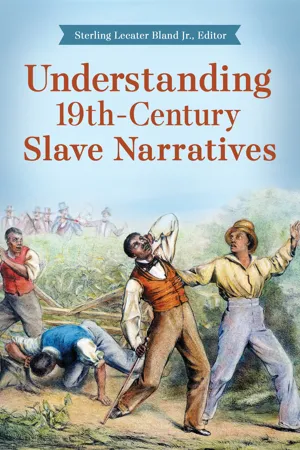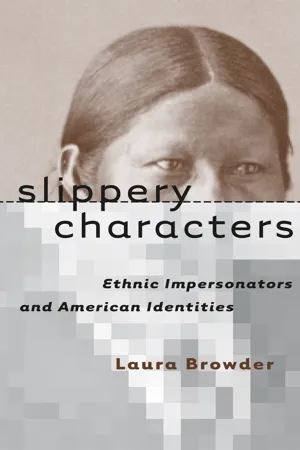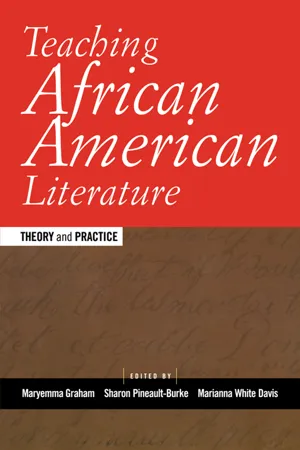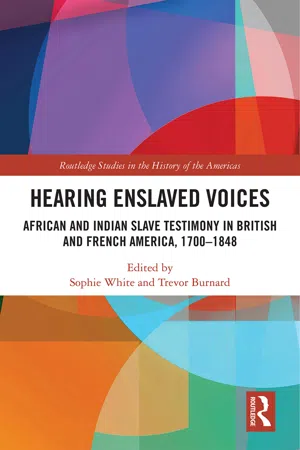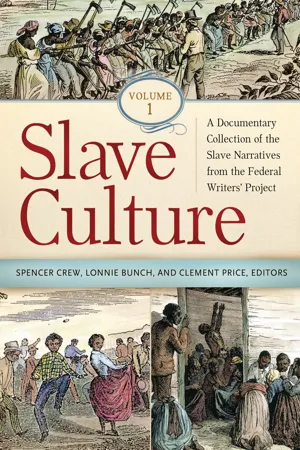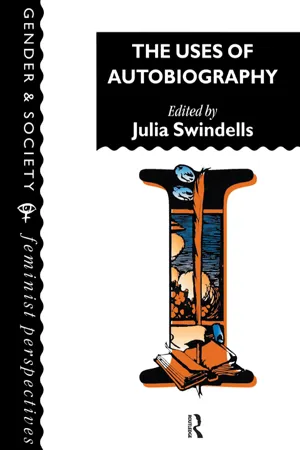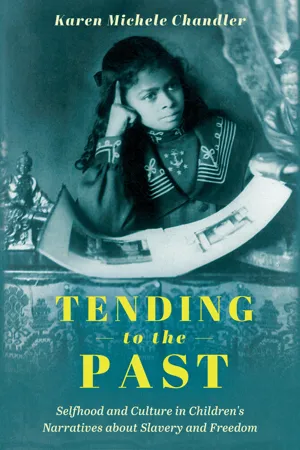Literature
Slave Narrative
A slave narrative is a literary genre that presents the autobiographical accounts of enslaved individuals. These narratives provide firsthand perspectives on the experiences of slavery, including the hardships, abuse, and struggles for freedom. They serve as important historical and cultural documents, shedding light on the inhumane treatment of enslaved people and their resilience in the face of oppression.
Written by Perlego with AI-assistance
Related key terms
Related key terms
1 of 4
Related key terms
1 of 3
9 Key excerpts on "Slave Narrative"
- eBook - ePub
- Sterling Lecater Bland Jr.(Author)
- 2016(Publication Date)
- Greenwood(Publisher)
The popularity of the nineteenth-century fugitive Slave Narrative as a genre was based on a number of circumstances. These included the complex interrelationship between the increasing influence of abolitionist activity, the increasing political debate about slavery, the public desire to read about the experiences of slaves, and an increasing interest in the first-person accounts of the effects of slavery on individuals.Slave Narratives are both historical documents and important literary documents. They explain the experiences of their narrators and document the inequality that existed between the ideals contained in the nation’s founding documents and the lived experiences of the nation’s African American citizens. Slave Narratives also occupy an important relationship to the presentation of race and inequality in canonical literature like Uncle Tom’s Cabin by Harriet Beecher Stowe and Mark Twain’s Adventures of Huckleberry Finn (1884). Their influence can also be felt both in contemporary autobiographical literature like Richard Wright’s Black Boy (1945) and Malcolm X’s Autobiography of Malcolm X (1965) and fictional literature like William Styron’s Confessions of Nat Turner (1967), Toni Morrison’s Beloved (1987), The Known World (2003) by Edward P. Jones, and Manu Herbstein’s Brave Music of a Distant Drum (2011). Slave narrators like William Wells Brown or James W. C. Pennington and the fictional characters inspired by their experience provide important commentary on the nation’s ongoing conversation about race, inequality, and identity.STYLISTIC DEVELOPMENTS
While the lives of southern blacks were sharply defined by the hardships of chattel slavery, the lives of blacks throughout the nation were also defined by economic hardship, legal constraint, the inability to vote, and other forms of racial discrimination. The conditions of blacks throughout the country and in the Caribbean created an environment in which black insurrection was a constant possibility. Among many others, organized uprisings were led by Toussaint L’Ouverture in the French colony of Saint-Domingue, which led to the establishment of the Republic of Haiti (1793–1801), Gabriel Prosser in Richmond, Virginia (1800), Denmark Vesey in Charleston, South Carolina (1822), and Nat Turner in Southampton, Virginia (1831). With the exception of the Saint-Domingue revolution, most of the other insurrections resulted in the capture and eventual execution of their organizers.2 - eBook - ePub
Cultural Studies of the United States
Ethnic Impersonators and American Identities
- Laura Browder(Author)
- 2003(Publication Date)
- The University of North Carolina Press(Publisher)
When a slave wrote about his or her disguise, it was always in the context of gaining freedom. Reader and writer colluded for a straightforward purpose, and the compact they made, although designed to lead to change in the public arena, was fashioned within a private context. It was unspectacular. Slave Narratives were read not just in a political but in a literary context. The antebellum Slave Narrative was seen not only as politically effective but as the great literature of its time. One reviewer, minister Ephraim Peabody, offering a Homeric comparison, suggested that “if the Iliad should be thought not to present a parallel case, we know not where one who wished to write a modern Odyssey could find a better subject than in the adventures of a fugitive slave.” 9 Slave Narratives were seen to have the strength not merely of epic but of a peculiarly American form of epic. Theodore Parker, a prominent Transcendentalist, spoke of the Slave Narrative as the only form of literary production unique to America: “All the original romance of Americans is in them, not in the white man’s novel.” 10 Slaves did not have the legal privileges of Americans born free and equal, but within their narratives they made claims for their Americanness. Stearns, in introducing Henry Box Brown’s narrative, lauded Brown’s “endurance, worthy of a Spartan” and claimed that “no one can doubt, when they recollect that if the records of all nations, from the time when Adam and Eve first placed their free feet upon the soil of Eden, until the conclusion of the scenes depicted by Hildreth and Macauley, should be diligently searched, a parallel instance of heroism, in behalf of personal liberty, could not be found” (vi). The stress that so many editors and critics laid on the epic quality of the Slave Narrative was yet another guide for readers. Slave Narratives were not treated as other autobiographies by readers - eBook - ePub
Teaching African American Literature
Theory and Practice
- Maryemma Graham, Sharon Pineault-Burke, Marianna White Davis(Authors)
- 2013(Publication Date)
- Routledge(Publisher)
It is the style of her self-representation, the myth of herself, that she consciously fashions for the San Francisco Railway Commission that gets her the job she is after. Thus the imaginative manipulation of her identity in that job application actually enables Angelou to become the authentic person she wants to be. Hence the importance of writing, style, to the goal of self-realization in and through autobiography. Here are a few key terms that can help students get a handle on the key concerns, the defining parameters, of any Slave Narrative. First, what is a Slave Narrative? A Slave Narrative, in its earliest form, was simply an account of the life, or a major portion of the life, of a fugitive or former slave, either written or in some way orally related by the slave himself or herself. The two themes that are most often identified with the Slave Narrative are freedom and literacy. Freedom, of course, is most simply the antithesis of slavery. In the nineteenth-century Slave Narrative freedom is understood 1. most naively as a place—the North. 2. most pragmatically as an economic condition, in which one can dispose of one’s own labor according to one’s own inclination. 3. most ideally as a state of the mind and spirit characterized by a sense of awareness of self and a sense of individual potential to affect the world and to effect one’s own future. Slavery is not only the absence of freedom. As Douglass was among the first of the slave narrators to demonstrate, slavery was designed to deny black people access to the meaning and value of freedom. It’s not enough to place people in bondage; slavery must convince the slave that he or she is properly situated in bondage. Thus in a classic Slave Narrative such as Douglass’s, and in important successors such as Wright’s Black Boy, slavery’s physical cruelty is not stressed as much as its attack on the development of the slave’s psychological, intellectual, and spiritual sense of self - eBook - ePub
Hearing Enslaved Voices
African and Indian Slave Testimony in British and French America, 1700–1848
- Sophie White, Trevor Burnard(Authors)
- 2020(Publication Date)
- Routledge(Publisher)
1 For the period and places that we study here—the French and British Atlantic Worlds in the period between 1700 and 1848—such materials are less plentiful, though see the qualification to this statement noted below. This relative scarcity of texts leads to a major problem for scholars of slavery in this period and place: We can usually only study enslavement from one perspective, that of the enslaver rather than the enslaved. Moreover, most of the voices of the enslaved within the archives of colonial slavery are heavily mediated, frequently taking the form of dictated texts or portraits and representations by others. Given how crucial slavery was to the success of these empires and to racialization in this period, the absence of the enslaved voice is a serious problem for truly understanding the dynamics of enslavement and what slavery did to the psyche of the enslaved.There are, however, more potential Slave Narratives, by enslaved African Americans and Native Americans, than most scholars think that exist outside the conventional archive of Slave Narratives of the American South that are so often taken as emblematic of the enslaved experience in the Americas. Narratives that are often fragmentary, if revealing, are the ones that animate the chapters in this book, and (except for those discussed by Aaron Spencer Fogleman, which resemble the Slave Narratives of the antebellum American South) they consist almost exclusively of testimony presented in court or before some legal entity or another. They can be extraordinarily powerful narratives, as is shown consistently in the essays in this book. Both editors have a long-standing interest in expanding the canon of what might constitute a Slave Narrative. Sophie White, one of the editors of this volume, has shown, through a detailed examination of the testimony of enslaved people whose voices can be heard in the methodologically complicated but empirically rich records of judicial proceedings in mid-eighteenth-century New Orleans, how we can use such texts to overhear the fragmented yet compelling ways in which the enslaved communicated in often hostile settings their experiences of being enslaved. The enslaved lived in often frightening worlds in which people other than themselves set the rules and devised punishments for breaking rules that the enslaved had no part in making, yet they sought over and over to convey their values and, especially, to express their commitment to family and to the people they loved within institutional structures strongly opposed to their interests.2 Similarly, Trevor Burnard, the other editor of this book, has worked extensively on rich records kept about enslaved people complaining to a government official about their treatment under enslavement in Berbice, in north-east South America in the second and third decades of the nineteenth century, illustrating that enslaved people in this time and place strived to voice their views, just like the Louisiana slaves studied by White did. The content of the complaints is itself mesmerizing, but it is the details contained within the complaints and how such complaints were fashioned—creating, as Cécile Vidal notes in an essay in this volume, ‘Fiction in the Archives’—complex and multifaceted narratives out of testimony in often-charged environments. His work will lead to a book on enslaved women in Berbice which will complement work by Randy Browne using some of the same records on how enslaved people “survived” slavery.3 - eBook - ePub
To Tell a Free Story
The First Century of Afro-American Autobiography, 1760-1865
- William L. Andrews(Author)
- 2022(Publication Date)
- University of Illinois Press(Publisher)
The enlistment of the self, through the autobiographical act, in the antislavery movement required, subtly and simultaneously, literary acts of resistance to the antislavery movement in order to preserve the text as autobiography and the narrator as an independent entity, something more than a coopted organization man. Tensions, disjunctions, and silences can serve as an index to a struggle going on in a narrative between its role as the work of a movement, identified by its consistency with the ideology of the movement, and its role as the text of an other, identified by its inconsistency, its unresolved relationship within and without the movement. Historical scholarship on the role of blacks in the antislavery movement confirms the tense, often suppressed conflicts between ex-slaves and white reformers over authority and priorities. 18 The writing of Slave Narratives was informed by and in some ways reflects these tensions. The literary autonomy of men like Douglass, Brown, and Bibb, though greater than that of most black autobiographers before them, was nevertheless restricted by those who seemed to encourage them most in their literary efforts. The antislavery movement did not provide them a forum for their speaking and writing just so that they could express themselves. Slave Narratives were solicited and published to promote the great social aim of abolitionism, not the personal needs of an individual. Slave narrators were not always free creative agents who could make what they wished of the facts of their lives. As public men and professional fugitives these men were the creatures of abolitionism. They knew that the autobiographies they wrote were in a crucial sense not their own. They were shared property with the antislavery movement on whose platform and in whose press they had taken form and significance. Thus the movement itself formed the slave narrator’s first and probably most critical audience - eBook - ePub
The New Slave Narrative
The Battle Over Representations of Contemporary Slavery
- Laura Murphy(Author)
- 2019(Publication Date)
- Columbia University Press(Publisher)
29 Global narratives of sexual enslavement have also been published, primarily focused on regions of the world where the United States is engaged in conflict—North Korea, Iraq, and Syria in particular. Those narratives recount young women’s captivity by repressive regimes or by opportunistic bystanders who use sexual exploitation as a means of political and ethnic subordination. Their escapes typically depend on their rescue by religious or political groups who assist them in migrating to the West. Only four of the narratives published during this period depict labor trafficking exclusively, and all but one of those narratives are by women. In the years since 2010, the diversity of the archive of slavery and the Slave Narrative has been considerably constricted.Nonetheless, since the publication of the two Sudanese narratives, hardly a year has gone by without the publication of at least one new Slave Narrative, and by 2015, several were emerging each year, encouraged by an ever-expanding publication terrain. In this book, I will be concentrating on the forty-one book-length narratives written by thirty-six individual authors that had been published through the summer of 2018 (when this book was submitted for publication), but new narratives that could potentially be included emerge regularly. Readers should consult the appendix for a list of all narratives included in this study. The book-length narratives differ from the shorter Slave Narratives that have been collected by nonprofits or in court testimony in that they are typically more explicitly intended by their authors to provoke a political response through the narration of a first-person experience of enslavement. Whereas the narratives presented in collections, in court proceedings, or for the use of nonprofits may have been offered by the survivor with a variety of purposes in mind—gaining asylum, accessing services, prosecuting a trafficker—the narratives composed as books have the express purpose of effecting change and thus represent a particular strain or body of Slave Narrative. There are many aspects of these texts that are worthy of critical pursuit, but I have foregrounded dominant areas of inquiry and debate here in this first foray. This book is meant to serve as a starting point for a discussion of the “new Slave Narrative” and as a transition point for the scholarship surrounding the study of the Slave Narrative, and as such, it cannot aim to account for all narratives and all aspects of the narratives given the constraints of publication. - eBook - ePub
Slave Culture
A Documentary Collection of the Slave Narratives from the Federal Writers' Project [3 volumes]
- Spencer R. Crew, Lonnie G. Bunch III, Clement A. Price, Spencer R. Crew, Lonnie G. Bunch III, Clement A. Price(Authors)
- 2014(Publication Date)
- Greenwood(Publisher)
Introduction: The History of the Slave Narratives
The Slave Narrative project, created by the Works Progress Administration (WPA) during the presidency of Franklin Delano Roosevelt, represents a valuable compendium of information about the institution of slavery. The project contains the recollections of elderly African Americans living in the 1930s who grew up during the era of slavery in the United States. In their testimonies these men and woman describe the difficulties of life under slavery and the steps they took to create safe places where they could preserve their humanity and nurture their relationships with family and friends. Their words are both powerful and poignant, making their existence under slavery a very tangible and personal experience for readers of their words. They offer a view of the institution of slavery from the inside out. Their testimonies provide a sense of the day-to-day challenges faced by enslaved people. Their experiences at times are very hard to read. Brutality and mistreatment are routine occurrences in their lives. Learning how to protect themselves and their families from the worst aspects of the institution is important to their survival. Theirs is a very different view of slavery than the perspective offered by slaveholders of the period. It was not the benign institution many apologists for slavery have described. Although sentimental bonds did occur between the enslaved and their enslavers, most often slavery was harsh as well as physically and emotionally exhausting. The people whose reminiscences were captured were among the lucky ones who survived enslavement and lived long enough to share their stories with the interviewers who recorded their experiences. Both moments of joy and moments of immense sorrow characterize their accounts.It is interesting that the stories of these formerly enslaved persons might have been lost had not the nation suffered economic duress. The stock market crash of 1929 was a catastrophe for the country. People lost their jobs, homes, and at times their hope for the future. The economic depression that followed led to the election of Franklin Delano Roosevelt as president and his subsequent endeavors to identify actions that might slow or end the economic downturn. Among the many ideas he implemented was the creation of programs to provide employment for some of the thousands of people out of work. The WPA. established in 1935, was created specifically to give jobs to the unemployed to toil on public work projects, such as constructing bridges, dams, roads, or buildings. One of the offshoots of the WPA was the Federal Writers’ Project, also created in 1935. Its agenda was to provide work for historians, teachers, writers, and other white-collar workers on projects that leveraged their skills and education. The project’s initial goal was to produce a series of guide books, called The American Guide - eBook - ePub
- Cambridge. Julia Swindells Homerton College(Author)
- 2014(Publication Date)
- Taylor & Francis(Publisher)
Chapter 6 Autobiography, Authenticity and Nineteenth-century Ideas of Race PART ONE Sentimentality and the Slave Narrative: Frederick Douglass’ My Bondage and My Freedom Sarah Meer The fugitive slave, Frederick Douglass, wrote his first autobiography, now regarded as the classic Slave Narrative, the Narrative of the Life of Frederick Douglass, An American Slave, in 1845. 1 By the time he wrote his second autobiography, My Bondage and My Freedom, ten years later, he had a substantially new story to tell. 2 Douglass’ first autobiography was written with the encouragement of the Massachusetts Anti-Slavery Society for whom he had worked as an abolitionist lecturer from 1841. His Narrative set down in print a story he had by then told many times on anti-slavery platforms around the States, and it clearly shows his commitment to the brand of abolitionist politics espoused by William Lloyd Garrison. Like many nineteenth-century Slave Narratives it was driven by a commitment to what may be called a ‘historical’ and also to a ‘rhetorical’ purpose. 3 Douglass’ narrative related the facts of his life, and also aimed to persuade its readers of the iniquities of slavery and the validity of the abolitionist cause. The second autobiography was published after a traumatic split with Garrison and the American Anti-Slavery Society but Douglass was still trying to expose the wrongs of slavery by writing his life. 4 Covering the intervening years of freedom, whereas the first book dealt mainly with Douglass’ life in slavery, My Bondage and My Freedom charts his growing political independence over these years, and the eventual break with the Gamsonians. Most interestingly for students of autobiography, it also goes over some of the ground covered ten years earlier, and by filling in certain details and adding particular emphases, produces a significantly different sense of places and events - eBook - ePub
Tending to the Past
Selfhood and Culture in Children's Narratives about Slavery and Freedom
- Karen Michele Chandler(Author)
- 2024(Publication Date)
- University Press of Mississippi(Publisher)
Chapter 4 Stealing Letters Freedom Narratives, Literacy, and Black Vernacular TraditionsMany historical texts designed for children present literacy as a principal means through which enslaved persons secure freedom and are thus aligned with nineteenth-century Slave Narratives’ portrayal of the liberating power of literacy. Yet as Paula Connolly has observed, neo-Slave Narratives do not simply conform to the conventions of antebellum Slave Narratives; they transform them (200). This is demonstrated by the freedom narratives I discuss in this chapter: Charles Burnett’s Nightjohn (1996), Patricia McKissack’s A Picture of Freedom: The Diary of Clotee, a Slave Girl (1997), and Joyce Hansen’s I Thought My Soul Would Rise and Fly: The Diary of Patsy, a Freed Girl (1997). These narratives present literacy in league with other means of reaching freedom derived from Black folk culture, including songs, tales, and character types, like the trickster. These features of the Black vernacular were long important within Black communities for cultural definition, orientation, and education, as well as entertainment. Literacy, by contrast, functioned as one of the “master’s tools,” the expressive and political powers controlled and employed by white patriarchy; before the Civil War, African Americans had limited access to literacy (Lorde 112). In Burnett’s, Hansen’s, and McKissack’s narratives, as well as in other freedom narratives, Black children bring literacy and aspects of Black vernacular, especially oral, culture together to empower themselves, whether they are enslaved or newly free. With the help of print and oral traditions, all three narratives’ Black girl protagonists rise above dire conditions and begin to fashion better lives for themselves: They speak and act for themselves both within and outside the Black community; they manipulate words to secure social advantages for themselves and others; and they help to shape and preserve a body of Black communal knowledge. In manifesting the girls’ creativity and agency, these actions reflect the liberatory values of the Black Arts Movement, particularly the importance of freeing Black self-expression. Surprisingly, these characters and narratives are products of large media companies, Disney and Scholastic, and thus these particular narratives suggest the viability in the late 1990s of popularizing radical Black thought, although their messaging was by no means commonplace.1
Index pages curate the most relevant extracts from our library of academic textbooks. They’ve been created using an in-house natural language model (NLM), each adding context and meaning to key research topics.
Explore more topic indexes
Explore more topic indexes
1 of 6
Explore more topic indexes
1 of 4
